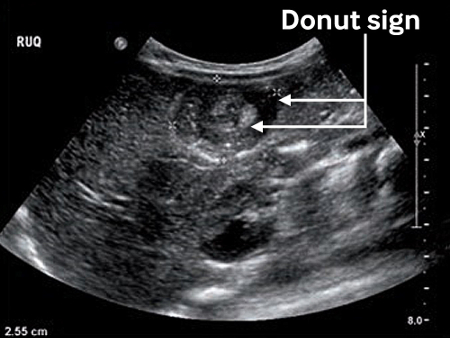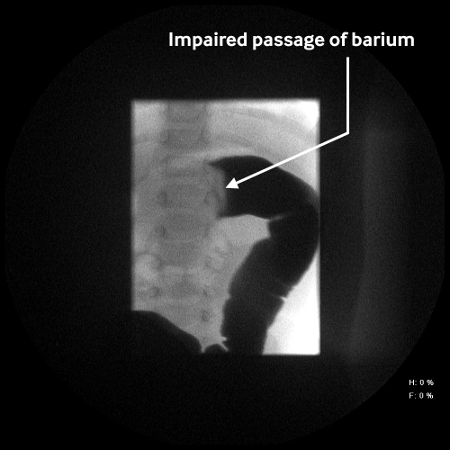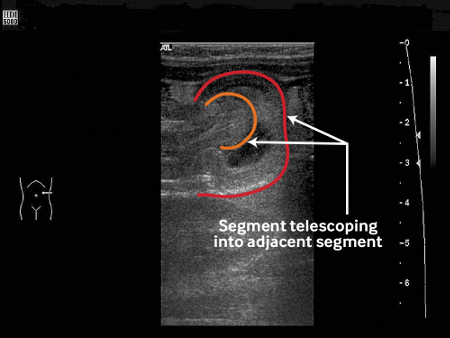History
Most cases occur in children younger than 12 months. Patients should be assessed first with a complete history and physical exam with a focus on the nature of abdominal pain (colicky/intermittent episodes versus constant), the presence of red currant jelly stools, and the presence or absence of vomiting. Almost all infants with intussusception present with abdominal pain and vomiting.[17]American College of Radiology. ACR Appropriateness Criteria: Vomiting in Infants. 2020 [internet publication].
https://acsearch.acr.org/docs/69445/Narrative
The classic symptom of red currant jelly stool or rectal bleeding is present in 35% to 73% of cases.[3]Justice FA, Auldist AW, Bines JE. Intussusception: trends in clinical presentation and management. J Gastroenterol Hepatol. 2006 May;21(5):842-6.
http://www.ncbi.nlm.nih.gov/pubmed/16704533?tool=bestpractice.com
[11]O'Ryan M, Lucero Y, Pena A, et al. Two year review of intestinal intussusception in six large hospitals of Santiago, Chile. Pediatr Infect Dis J. 2003 Aug;22(8):717-21.
http://www.ncbi.nlm.nih.gov/pubmed/12913773?tool=bestpractice.com
[18]Blanch AJ, Perel SB, Acworth JP. Paediatric intussusception: epidemiology and outcome. Emerg Med Australas. 2007 Feb;19(1):45-50.
http://www.ncbi.nlm.nih.gov/pubmed/17305660?tool=bestpractice.com
Progressive lethargy is often associated, and patients may have a history of a recent viral illness.[3]Justice FA, Auldist AW, Bines JE. Intussusception: trends in clinical presentation and management. J Gastroenterol Hepatol. 2006 May;21(5):842-6.
http://www.ncbi.nlm.nih.gov/pubmed/16704533?tool=bestpractice.com
Physical exam
Physical exam should begin with an assessment of hemodynamic stability. Abdominal exam may yield findings of a palpable abdominal mass, abdominal distention, or even peritonism.[1]Marsicovetere P, Ivatury SJ, White B, et al. Intestinal intussusception: etiology, diagnosis, and treatment. Clin Colon Rectal Surg. 2017 Feb;30(1):30-9.
https://www.thieme-connect.de/products/ejournals/abstract/10.1055/s-0036-1593429
http://www.ncbi.nlm.nih.gov/pubmed/28144210?tool=bestpractice.com
The abdominal mass may be subtle and examination is best performed when the infant is settled in between colic bouts. The clinician may wish to examine for a mass when the child is on their caregiver’s lap; the infant may be more settled, and the mass might be more readily palpable when the patient is prone or lateral.
Blood on digital rectal exam may be found but its absence does not refute the diagnosis. Hypovolemic shock, suggestive of intestinal ischemia or necrosis, is present in 5% to 10% of cases.[3]Justice FA, Auldist AW, Bines JE. Intussusception: trends in clinical presentation and management. J Gastroenterol Hepatol. 2006 May;21(5):842-6.
http://www.ncbi.nlm.nih.gov/pubmed/16704533?tool=bestpractice.com
Imaging studies
The finding of a target sign (variants according to appearance or imaging modality include bull’s eye sign, donut sign, crescent-in-donut sign, and multiple concentric ring sign) is characteristic of intussusception on plain-film abdominal x-rays or less commonly by computed tomography (CT).[1]Marsicovetere P, Ivatury SJ, White B, et al. Intestinal intussusception: etiology, diagnosis, and treatment. Clin Colon Rectal Surg. 2017 Feb;30(1):30-9.
https://www.thieme-connect.de/products/ejournals/abstract/10.1055/s-0036-1593429
http://www.ncbi.nlm.nih.gov/pubmed/28144210?tool=bestpractice.com
[19]Plut D, Phillips GS, Johnston PR, et al. Practical imaging strategies for intussusception in children. AJR Am J Roentgenol. 2020 Dec;215(6):1449-63.
https://www.doi.org/10.2214/AJR.19.22445
http://www.ncbi.nlm.nih.gov/pubmed/33084362?tool=bestpractice.com
[Figure caption and citation for the preceding image starts]: Transverse sonogram of the abdomen showing the donut sign (concentric rings within the lumen of a distended loop of bowel)Adapted from the Student BMJ. 2008;16:76. Copyright 2010 by the BMJ Publishing Group; used with permission [Citation ends].
CT scans are normally not indicated for the routine evaluation of abdominal pain or intussusception in children.[19]Plut D, Phillips GS, Johnston PR, et al. Practical imaging strategies for intussusception in children. AJR Am J Roentgenol. 2020 Dec;215(6):1449-63.
https://www.doi.org/10.2214/AJR.19.22445
http://www.ncbi.nlm.nih.gov/pubmed/33084362?tool=bestpractice.com
[20]American Academy of Pediatrics. Ten things physicians and patients should question. Choosing Wisely, an initiative of the ABIM Foundation. 2022 [internet publication].
https://web.archive.org/web/20230325225612/https://www.choosingwisely.org/societies/american-academy-of-pediatrics
However, CT may be valuable for diagnosing pathologic lead points and identifying unsuspected intussusception in children with atypical abdominal signs and symptoms.[19]Plut D, Phillips GS, Johnston PR, et al. Practical imaging strategies for intussusception in children. AJR Am J Roentgenol. 2020 Dec;215(6):1449-63.
https://www.doi.org/10.2214/AJR.19.22445
http://www.ncbi.nlm.nih.gov/pubmed/33084362?tool=bestpractice.com
Plain abdominal films may be normal, although occasionally a partial intestinal obstruction may be seen. Other suggestive signs include the presence of a soft-tissue mass, an empty right lower quadrant, air in a dislocated appendix, and signs of a small-bowel obstruction.[21]Sorantin E, Lindbichler F. Management of intussusception. Eur Radiol. 2004 Mar;14(suppl 4):L146-54.
http://www.ncbi.nlm.nih.gov/pubmed/14752570?tool=bestpractice.com
[22]del-Pozo G, Albillos JC, Tejedor D, et al. Intussusception in children: current concepts in diagnosis and enema reduction. Radiographics. 1999 Mar-Apr;19(2):299-319.
http://pubs.rsna.org/doi/full/10.1148/radiographics.19.2.g99mr14299
http://www.ncbi.nlm.nih.gov/pubmed/10194781?tool=bestpractice.com
If peritonitis is present, immediate surgical consultation is advised, and abdominal plain-film x-rays should be assessed for the presence of pneumoperitoneum. The presence of pneumoperitoneum is indicative of intestinal perforation as a complication of intussusception.
A contrast enema (air or contrast reagent) can be performed to diagnose intussusception but is contraindicated in the presence of pneumoperitoneum. Liquid or air enema remain the most specific and sensitive diagnostic tests and can localize the extent of the process. The diagnostic efficacy of liquid contrast and air enema may be comparable.[22]del-Pozo G, Albillos JC, Tejedor D, et al. Intussusception in children: current concepts in diagnosis and enema reduction. Radiographics. 1999 Mar-Apr;19(2):299-319.
http://pubs.rsna.org/doi/full/10.1148/radiographics.19.2.g99mr14299
http://www.ncbi.nlm.nih.gov/pubmed/10194781?tool=bestpractice.com
In one Cochrane review, air enema was seen to be more effective than liquid contrast for reducing intussusception, although the evidence base was deemed low quality.[23]Gluckman S, Karpelowsky J, Webster AC, et al. Management for intussusception in children. Cochrane Database Syst Rev. 2017 Jun 1;6:CD006476.
http://www.ncbi.nlm.nih.gov/pubmed/28567798?tool=bestpractice.com
In many centers, ultrasound is favored for the diagnosis of intussusception.[24]Tsou PY, Wang YH, Ma YK, et al. Accuracy of point-of-care ultrasound and radiology-performed ultrasound for intussusception: a systematic review and meta-analysis. Am J Emerg Med. 2019 Sep;37(9):1760-9.
https://www.doi.org/10.1016/j.ajem.2019.06.006
http://www.ncbi.nlm.nih.gov/pubmed/31182360?tool=bestpractice.com
If the patient is clinically stable and perforation is not suspected, ultrasonography should be the initial diagnostic test for intussusception. Ultrasound has a reported diagnostic accuracy of up to 100%.[24]Tsou PY, Wang YH, Ma YK, et al. Accuracy of point-of-care ultrasound and radiology-performed ultrasound for intussusception: a systematic review and meta-analysis. Am J Emerg Med. 2019 Sep;37(9):1760-9.
https://www.doi.org/10.1016/j.ajem.2019.06.006
http://www.ncbi.nlm.nih.gov/pubmed/31182360?tool=bestpractice.com
The presence of a 3 to 5 cm mass just deep to the right-sided abdominal wall with the characteristic donut sonographic appearance is diagnostic of intussusception. Ultrasound may also identify the presence or absence of a pathologic lead point (an associated anatomic abnormality of the intestine such as a luminal polyp or mass lesion that may lead to the development of intussusception).[25]Khasawneh R, El-Heis M, Al-Omari M, et al. The radiological characteristics of childhood intussusception including unusual features and rare pathological lead points. Heliyon. 2021 Jun;7(6):e07231.
https://www.doi.org/10.1016/j.heliyon.2021.e07231
http://www.ncbi.nlm.nih.gov/pubmed/34169171?tool=bestpractice.com
Mesenteric blood flow can also be assessed by ultrasound, the absence of which is predictive of bowel-wall necrosis and irreducibility.[26]Lim HK, Bae SH, Lee KH, et al. Assessment of reducibility of ileocolic intussusception in children: usefulness of color doppler sonography. Radiology. 1994 Jun;191(3):781-5.
https://www.doi.org/10.1148/radiology.191.3.8184064
http://www.ncbi.nlm.nih.gov/pubmed/8184064?tool=bestpractice.com
[Figure caption and citation for the preceding image starts]: Abdominal x-ray showing impaired passage of barium at site of obstruction due to intussusceptionFrom the collection of Dr David J. Hackam; used with permission [Citation ends]. [Figure caption and citation for the preceding image starts]: Ultrasound image showing invagination of a segment of bowel into the adjacent segmentBMJ Case Reports. 2009; doi:10.1136/bcr.04.2009.1730; used with permission [Citation ends].
[Figure caption and citation for the preceding image starts]: Ultrasound image showing invagination of a segment of bowel into the adjacent segmentBMJ Case Reports. 2009; doi:10.1136/bcr.04.2009.1730; used with permission [Citation ends]. [Figure caption and citation for the preceding image starts]: Transverse sonogram of the abdomen showing the donut sign (concentric rings within the lumen of a distended loop of bowel)Adapted from the Student BMJ. 2008;16:76. Copyright 2010 by the BMJ Publishing Group; used with permission [Citation ends].
[Figure caption and citation for the preceding image starts]: Transverse sonogram of the abdomen showing the donut sign (concentric rings within the lumen of a distended loop of bowel)Adapted from the Student BMJ. 2008;16:76. Copyright 2010 by the BMJ Publishing Group; used with permission [Citation ends].

 [Figure caption and citation for the preceding image starts]: Ultrasound image showing invagination of a segment of bowel into the adjacent segmentBMJ Case Reports. 2009; doi:10.1136/bcr.04.2009.1730; used with permission [Citation ends].
[Figure caption and citation for the preceding image starts]: Ultrasound image showing invagination of a segment of bowel into the adjacent segmentBMJ Case Reports. 2009; doi:10.1136/bcr.04.2009.1730; used with permission [Citation ends]. [Figure caption and citation for the preceding image starts]: Transverse sonogram of the abdomen showing the donut sign (concentric rings within the lumen of a distended loop of bowel)Adapted from the Student BMJ. 2008;16:76. Copyright 2010 by the BMJ Publishing Group; used with permission [Citation ends].
[Figure caption and citation for the preceding image starts]: Transverse sonogram of the abdomen showing the donut sign (concentric rings within the lumen of a distended loop of bowel)Adapted from the Student BMJ. 2008;16:76. Copyright 2010 by the BMJ Publishing Group; used with permission [Citation ends].